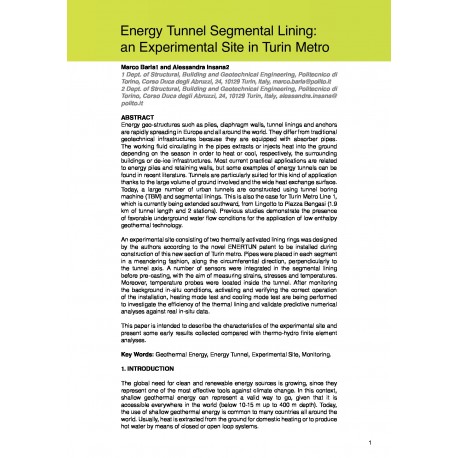Cart
0
0
No document
0,00 €
Total
Document successfully added to your shopping cart
Quantity
Total
There are 0 items in your cart.
There is 1 item in your cart.
Total documents
Total shipping
To be determined
Total
Search & filter
Search for a publication
Search & filter
Viewed documents
Energy Tunnel Segmental Lining: an Experimental Site in Turin Metro
3200_energy_tunnel_segmental_lin
Energy geo-structures such as piles, diaphragm walls, tunnel linings and anchors are rapidly spreading in Europe and all around the world. They differ from traditional geotechnical infrastructures because they are equipped with absorber pipes. The working fluid circulating in the pipes extracts or injects heat into the ground depending on the season in order to heat or cool, respectively, the surrounding buildings or de-ice infrastructures. Most current practical applications are related to energy piles and retaining walls, but some examples of energy tunnels can be found in recent literature. Tunnels are particularly suited for this kind of application thanks to the large volume of ground involved and the wide heat exchange surface. Today, a large number of urban tunnels are constructed using tunnel boring machine (TBM) and segmental linings. This is also the case for Turin Metro Line 1, which is currently being extended southward, from Lingotto to Piazza Bengasi (1.9 km of tunnel length and 2 stations). Previous studies demonstrate the presence of favorable underground water flow conditions for the application of low enthalpy geothermal technology. An experimental site consisting of two thermally activated lining rings was designed by the authors according to the novel ENERTUN patent to be installed during construction of this new section of Turin metro. Pipes were placed in each segment in a meandering fashion, along the circumferential direction, perpendicularly to the tunnel axis. A number of sensors were integrated in the segmental lining before pre-casting, with the aim of measuring strains, stresses and temperatures. Moreover, temperature probes were located inside the tunnel. After monitoring the background in-situ conditions, activating and verifying the correct operation of the installation, heating mode test and cooling mode test are being performed to investigate the efficiency of the thermal lining and validate predictive numerical analyses against real in-situ data.This paper is intended to describe the characteristics of the experimental site and present some early results collected compared with thermo-hydro finite element analyses. Geothermal Energy, Energy Tunnel, Experimental Site, Monitoring.




